

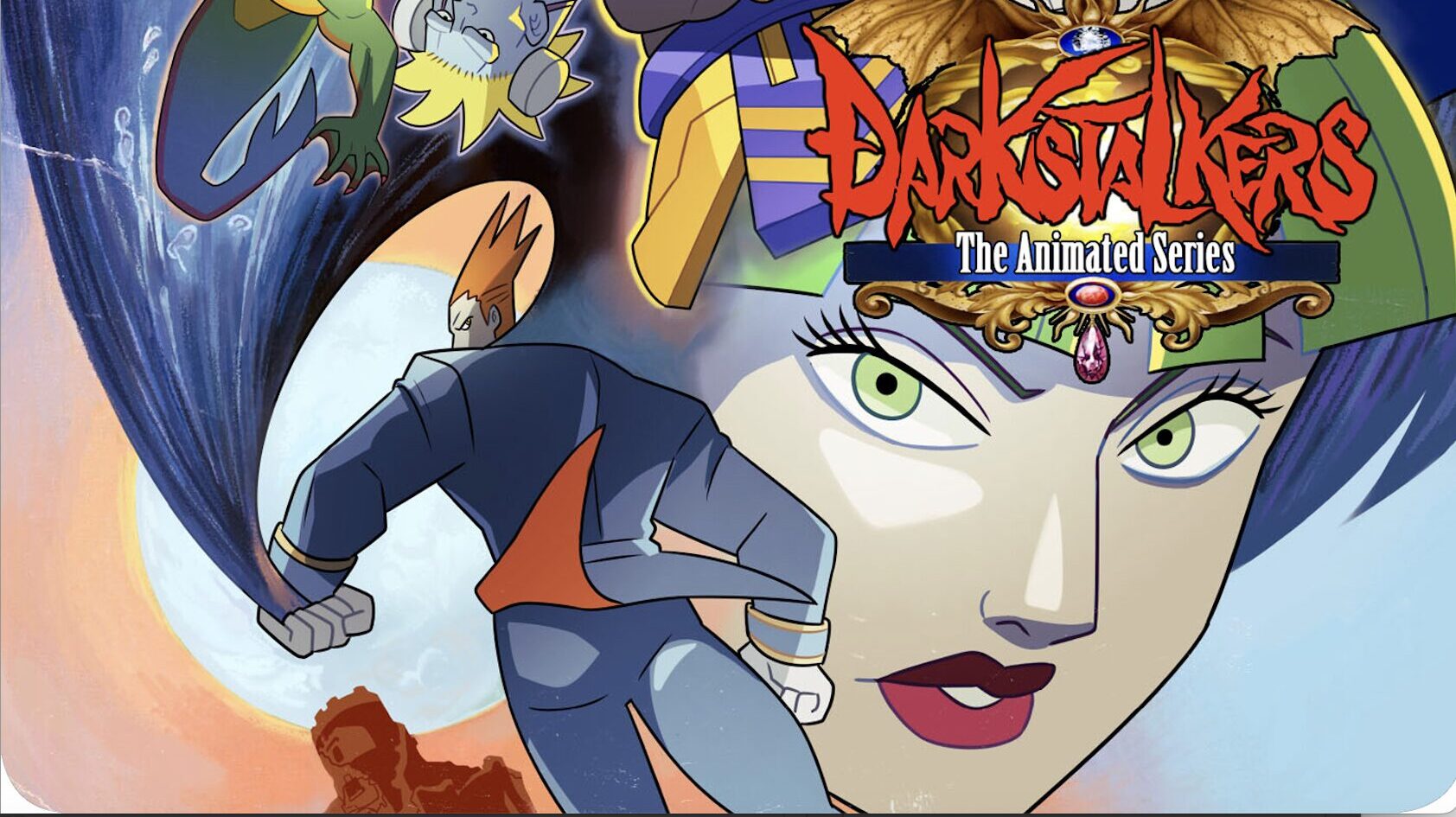
A few months ago I reviewed Street Fighter: The Animated Series and gave it a mild recommendation. Well now we have Darkstalkers, another American series based on a video game property, and it doesn’t quite hit the same sweet spot of simultaneous earnestness and goofiness. It’s just… dumb.
To explain why, we need to look at the Darkstalkers games for a brief moment. Something of an underdog fighting series compared to Capcom’s bigger Street Fighter franchise, its motley crew of monsters and mythical creatures were unique enough to leave an impression, and a small handful of its characters even made appearances in later games such as Marvel vs. Capcom. For its fans, what made the series work was its mix of the macabre and wacky comedy- one only needs to look at B.B. Hood, a parody of Little Red Riding Hood that totes an uzi and sports a sinister smile. The games had buttery smooth animation to accentuate the outlandish goings-on. The unique take on the various myths and classic monsters (you had a sasquatch, a Frankenstein’s Monster, a succubus, a mummy, a vampire, a merman, etc.) gave the games lots of personality. Such a varied premise would hypothetically make for a great animated adaptation, and it did get one… in Japan. Too bad we’re reviewing the American series, which was released two years earlier.
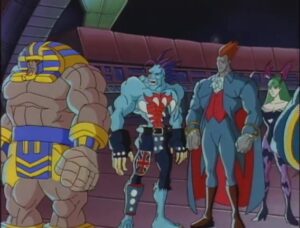 To be fair, the show does more or less superficially present the characters as they were in the games; you can tell who everyone is, and the designs don’t look radically different. But that’s where the similarities end. Each character’s signature moves and specials are virtually unrecognizable here; remember how the Street Fighter series would have characters call out their famous attacks? (“Sonic BOOOOM!”) You don’t get that here. But more than that, Darkstalkers is the epitome of a show that tones down the source material; everything feels “kiddified”. Nowhere is this more apparent than Morrigan, the aforementioned succubus who is supposed to exude sex appeal; she’s sanitized greatly. Even outside of that character, the show’s overall look and tone is much lighter than the games, to the point where it’s almost an in-name only version of the franchise.
To be fair, the show does more or less superficially present the characters as they were in the games; you can tell who everyone is, and the designs don’t look radically different. But that’s where the similarities end. Each character’s signature moves and specials are virtually unrecognizable here; remember how the Street Fighter series would have characters call out their famous attacks? (“Sonic BOOOOM!”) You don’t get that here. But more than that, Darkstalkers is the epitome of a show that tones down the source material; everything feels “kiddified”. Nowhere is this more apparent than Morrigan, the aforementioned succubus who is supposed to exude sex appeal; she’s sanitized greatly. Even outside of that character, the show’s overall look and tone is much lighter than the games, to the point where it’s almost an in-name only version of the franchise.
To add to the feel of a show aimed at a younger demographic, they felt the need to create a new pre-teen character, Harry, who wasn’t in the games. The show’s excuse for him existing was that he’s the descendant of Merlin, so he has special powers he can activate on command, such as floating in mid air and levitating objects. But he’s a flat character; there’s nothing interesting about him, either visually or personality-wise, and also puzzling is that catgirl Felicia teams up with him, so we get a couple cliched “hide Felicia from mom” bits, and there’s a lot of hand-waving going on that Harry is just able to duck out for long periods and go globetrotting with Felicia.
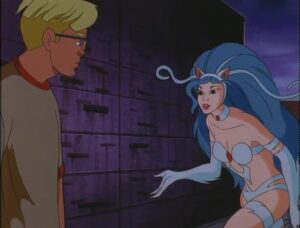 The first episode introduces most of the main characters, and since the Darkstalkers games have over a dozen, they try to debut most everyone in only 24 minutes, so it’s almost overwhelming; newcomers to the franchise will be thoroughly lost. It feels similar to the live action Street Fighter movie by trying to shoehorn everybody in. We get our main villain, Pyron, an alien engulfed by fire, who abducts various “bad” Darkstalkers to his spaceship base above Earth, and then commands them in his quest to take over the world. After that, the show settles into the more typical “one or two characters in the spotlight per episode”- monster hunter Donovan and a traumatized young girl named Anita who he takes under his wing get an episode (and is followed up on later), the undead Hsien-ko gets one, Sasquatch and his son are featured in another, werewolf Jon Talbain shares a plot with fellow furry Felicia, etc.
The first episode introduces most of the main characters, and since the Darkstalkers games have over a dozen, they try to debut most everyone in only 24 minutes, so it’s almost overwhelming; newcomers to the franchise will be thoroughly lost. It feels similar to the live action Street Fighter movie by trying to shoehorn everybody in. We get our main villain, Pyron, an alien engulfed by fire, who abducts various “bad” Darkstalkers to his spaceship base above Earth, and then commands them in his quest to take over the world. After that, the show settles into the more typical “one or two characters in the spotlight per episode”- monster hunter Donovan and a traumatized young girl named Anita who he takes under his wing get an episode (and is followed up on later), the undead Hsien-ko gets one, Sasquatch and his son are featured in another, werewolf Jon Talbain shares a plot with fellow furry Felicia, etc.
The writing makes the Street Fighter series look smartly plotted and positively respectful of its lore by comparison. It really feels like the writers didn’t know what to do with these characters so they just took their Capcom-provided backstories and then made up generic plots to fit them into. In addition, the whole “Pyron sending his minions to subdue the good Darkstalkers” felt pretty self-limiting, as we get variants of that plot a few times in the series. Perhaps the worst episode is, tragically, the finale: Besides ridiculous scenes of mummy Anakaris doing stand-up to a bunch of penguins and vampire Dmitri and succubus Morrigan being guests on a TV talk show (?), Pyron is revealed to have an older brother who’s coming to visit the ship. Pyron wants to put on a good impression that he’s coming along with his world domination plan nicely, so he convinces the good Darkstalkers to join the bad ones and put on a facade while his brother’s in town. (Why would the good Darkstalkers like Felicia agree to this? Oh nevermind) It’s so depressing they resorted to a cliched sitcom plot; talk about squandering the limitless possibilities of this setting and characters! And the final shot of the series is just embarrassing.
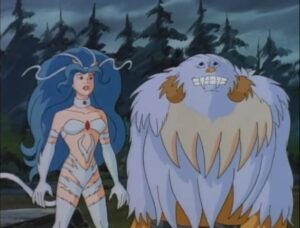 Remember earlier when I mentioned how good the sprite animation in the games was? Unfortunately, the series doesn’t hold the same quality. The animation, by Hyun Young Animation, has a “do the bare minimum” feel to it, looking no different than a substandard action series of the ‘90s. Even when characters perform fantastical special moves, everything just moves so lifelessly. There are some truly awkward bits of animation as well; check out a fight scene in episode 2 when Felicia turns from a cat back into her catgirl form, and her cel shuffles around the screen with no sense of space. Character designs are inconsistent; as a result, some moments look more on-model than others. Sometimes Dmitri has pupils, other times he doesn’t; sometimes Felicia has cat-like eyes, other times they look like human eyes. Lousy fight choreography that has no intensity to it rounds out the package. Street Fighter: The Animated Series may have been uneven at best, but at least there was an effort to give it a unique anime-imitating style, especially in season 2. You don’t get the same feel here; if this didn’t star such a kooky cast of characters, it would be indistinguishable from a number of American series. You can tell Hyun Young didn’t have the best quality control; in one of the episodes, a noticeable hair is present on the bottom of the screen for a good two minutes! We also get some errors that used to happen more often: Coloring inconsistencies, and when the wrong voice would come out of a character’s mouth. And the backgrounds? Uninspired and standard, compared to the eye candy of the games. I’ll give the show this: There is at least an attempt at fuller animation in parts of the first episode, but they abandon that pretty quickly.
Remember earlier when I mentioned how good the sprite animation in the games was? Unfortunately, the series doesn’t hold the same quality. The animation, by Hyun Young Animation, has a “do the bare minimum” feel to it, looking no different than a substandard action series of the ‘90s. Even when characters perform fantastical special moves, everything just moves so lifelessly. There are some truly awkward bits of animation as well; check out a fight scene in episode 2 when Felicia turns from a cat back into her catgirl form, and her cel shuffles around the screen with no sense of space. Character designs are inconsistent; as a result, some moments look more on-model than others. Sometimes Dmitri has pupils, other times he doesn’t; sometimes Felicia has cat-like eyes, other times they look like human eyes. Lousy fight choreography that has no intensity to it rounds out the package. Street Fighter: The Animated Series may have been uneven at best, but at least there was an effort to give it a unique anime-imitating style, especially in season 2. You don’t get the same feel here; if this didn’t star such a kooky cast of characters, it would be indistinguishable from a number of American series. You can tell Hyun Young didn’t have the best quality control; in one of the episodes, a noticeable hair is present on the bottom of the screen for a good two minutes! We also get some errors that used to happen more often: Coloring inconsistencies, and when the wrong voice would come out of a character’s mouth. And the backgrounds? Uninspired and standard, compared to the eye candy of the games. I’ll give the show this: There is at least an attempt at fuller animation in parts of the first episode, but they abandon that pretty quickly.
^ You WILL get sick of seeing this eyecatch multiple times per episode. (and don’t you love how Pyron’s flames overshadow all the characters behind him?)
The music also hurts matters; William Anderson has done plenty of good work but the styles he used for this show is largely forgettable synthesized orchestral and generic rock. Perhaps the worst offender is the goofy bouncy piece that often accompanies Felicia and Harry; it just makes you feel like it was written for some other franchise that’s not about monsters. Maybe it’s just because I’ve watched them more times, but I felt like the Street Fighter series had more memorable motifs than what we get here, and were more “game-like” in tone. (it certainly doesn’t hurt that Andrew Dimitroff referenced the Street Fighter theme many times) One big plus though: The ending theme uses “Trouble Man”, a catchy rock song that was also featured in the North American Playstation port of the first game. It’s a better song than this show deserves!
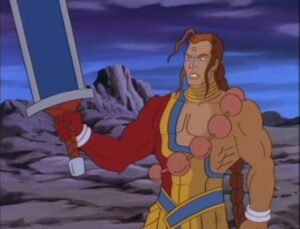 Voice acting, much like Street Fighter, is once again handled by Vancouver-based BLT Productions; unlike that show, however, I don’t consider most of the voices in here to be the “definitive” versions of the characters. Chief among the complaints is Morrigan; Saffron Henderson given her a Scottish accent that’s more distracting and slips in and out- you want a better performance, listen to Siobhan Flynn’s Morrigan in Marvel vs. Capcom 3. Michael Donovan, who I previously praised as Guile, seems miscast as Dmitri the vampire; I would’ve opted for a deeper voice myself, and in fact in the anime version of this franchise (more on that below), he was voiced in such a way by Paul Dobson. Richard Newman as the villain Pyron uses roughly the same voice as when he voiced M. Bison in Street Fighter, but it’s simply not as fun this time. Part of that is the flat writing for that character; there wasn’t much to work with (he stays on the ship all the time, so he’s not even involved in the action!). When I hear Pyron lording it over others, all I can think is how I’d much rather be watching him ham it up as Bison. Sasquatch’s son has one of the more annoying voices in the series and never shuts up, making his episode pure cringe. The Frankenstein’s Monster channeling Victor gets an Arnold Schwarzenegger-esque accent, which somehow feels very uncreative (“He’s got big muscles and he’s from Europe, give him an Ahnold voice!”). One word of praise, though: Scott McNeil as Lord Raptor, the guitar-playing skeleton. He gives him a British accent, and combined with the fact that much of his dialogue is lyric-based puns, makes him fun to listen to. He even reprised his role in the anime!
Voice acting, much like Street Fighter, is once again handled by Vancouver-based BLT Productions; unlike that show, however, I don’t consider most of the voices in here to be the “definitive” versions of the characters. Chief among the complaints is Morrigan; Saffron Henderson given her a Scottish accent that’s more distracting and slips in and out- you want a better performance, listen to Siobhan Flynn’s Morrigan in Marvel vs. Capcom 3. Michael Donovan, who I previously praised as Guile, seems miscast as Dmitri the vampire; I would’ve opted for a deeper voice myself, and in fact in the anime version of this franchise (more on that below), he was voiced in such a way by Paul Dobson. Richard Newman as the villain Pyron uses roughly the same voice as when he voiced M. Bison in Street Fighter, but it’s simply not as fun this time. Part of that is the flat writing for that character; there wasn’t much to work with (he stays on the ship all the time, so he’s not even involved in the action!). When I hear Pyron lording it over others, all I can think is how I’d much rather be watching him ham it up as Bison. Sasquatch’s son has one of the more annoying voices in the series and never shuts up, making his episode pure cringe. The Frankenstein’s Monster channeling Victor gets an Arnold Schwarzenegger-esque accent, which somehow feels very uncreative (“He’s got big muscles and he’s from Europe, give him an Ahnold voice!”). One word of praise, though: Scott McNeil as Lord Raptor, the guitar-playing skeleton. He gives him a British accent, and combined with the fact that much of his dialogue is lyric-based puns, makes him fun to listen to. He even reprised his role in the anime!
As I mentioned above, all of this would be bad enough but to add insult to injury, around the same time period Japan created its own Darkstalkers OVA, which is far superior. If nothing else, its animation quality is leagues better, its characters more faithfully represent their original counterparts, and while it debatably goes a little too far in the direction of putting the “dark” in Darkstalkers, I’ll take it over the dumbed down version that we got in America. Thankfully, both versions are available from Discotek; if you can only get one, I’d definitely opt for the anime. Certainly doesn’t hurt that it’s shorter; rather than wasting 6 hours of your life watching the American cartoon, the OVA can be watched in half that.
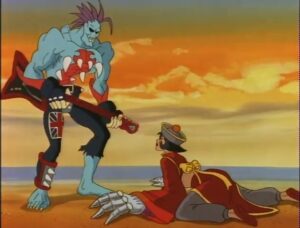 All 13 episodes are on one standard definition Blu-ray; picture quality is fine for what it is. As with the Street Fighter animated series Blu-ray, we get a Darkstalkers Stupidity video, a recreation of a YouTube Poop. Even there, it doesn’t have the same comedic value as the Street Fighter ones did; there just isn’t as much to laugh at out of context this time. Also included are three audio commentaries spearheaded by Discotek producer Brady Hartel and Matt McMuscles, who also did the commentaries for the Street Fighter set. That only three were recorded perhaps reflects the more “meh” nature to this show, though to their credit they do talk through the entire sessions and the commentary on episode 8 is the most interesting, as they read the original press release for the show and the very few Usenet viewer reviews that exist. Finally, we get a promo for the show and the original ending sequence, both utilizing some curious mixtures of early CG/stop motion and live action; I’m not sure why the credits were changed to the more standard “text on black background” but I’m glad it was included as a bonus. (Trivia: It was actually footage from the Japanese Darkstalkers game commercial)
All 13 episodes are on one standard definition Blu-ray; picture quality is fine for what it is. As with the Street Fighter animated series Blu-ray, we get a Darkstalkers Stupidity video, a recreation of a YouTube Poop. Even there, it doesn’t have the same comedic value as the Street Fighter ones did; there just isn’t as much to laugh at out of context this time. Also included are three audio commentaries spearheaded by Discotek producer Brady Hartel and Matt McMuscles, who also did the commentaries for the Street Fighter set. That only three were recorded perhaps reflects the more “meh” nature to this show, though to their credit they do talk through the entire sessions and the commentary on episode 8 is the most interesting, as they read the original press release for the show and the very few Usenet viewer reviews that exist. Finally, we get a promo for the show and the original ending sequence, both utilizing some curious mixtures of early CG/stop motion and live action; I’m not sure why the credits were changed to the more standard “text on black background” but I’m glad it was included as a bonus. (Trivia: It was actually footage from the Japanese Darkstalkers game commercial)
Even if you’re a fan of the games, I would give this show a pass; it is greatly sanitized and lightened, doesn’t have the artistic achievements of the Darkstalkers anime, and ultimately doesn’t amount to much. It’s not even as fun to watch from a WTF standpoint as Street Fighter was.
Discuss this article on the Toonzone Forums!
The post Review: Darkstalkers: The Animated Series (Blu-Ray): Don’t Stalk This One appeared first on Anime Superhero News.